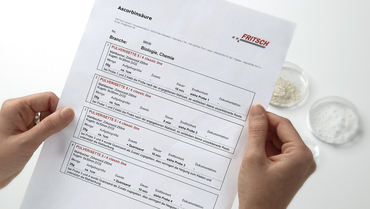Back to overview
Comminution of dog food
An effective sample preparation is essential for subsequent analysis
Dogs represent one of the most preferred pets across the globe. The general diet of a dog should comprise a combination of carbohydrates, minerals, proteins, fats, vitamins and water. Dog food manufacturers across the globe have been introducing products suitable for every stage of a dog’s life. Some of these products provide hypoallergenic nutrition, whereas other formulations are produced for controlling health conditions such as kidney and heart-related diseases[1].
Hence the importance of continued pet food testing for various ingredients or to even prevent contamination due to aflatoxin or salmonella. New technologies and testing methods for example are helping manufacturers and vet supply chains to keep products safe. FRITSCH Mills are perfectly suited for sample preparation prior to further testing of pet food.
First test with the Variable Speed Rotor Mill PULVERISETTE 14 premium line

In this trial we used our Variable Speed Rotor Mill PULVERISETTE 14 premium line converted into a cutting mill in combination with our high-performance Cyclone separator and 4 mm square perforated sieve shells.
Grinding parameter:
• Feed quantity: 200 g
• Feed Size: 10 mm
• Grinding Time: 1.40 min
• Final Fineness: 1 mm
We programmed the maximum speed setting of 18000 rpm and used a batch of 200 g of the dog food. The sample was fed slowly and was ground within 1:40 minutes. The grinding sound was typical during the grinding process.
Afterwards we inspected the grinding chamber: No perforations were clogged, but it could be seen that the sample was very greasy and gradually adhered to the sieve pan holder and the collecting vessel. We packed the sample and cleaned the Variable Speed Rotor Mill PULVERISETTE 14 premium line equipment with a soft brush and hot water.


Second Test with the FRITSCH Knife Mill PULVERISERTTE 11

In this trial, we used our Knife Mill PULVERISETTE 11, which was equipped with a standard grinding vessel made of plastic PC and a standard knife made of stainless steel.
Grinding parameter:
• Feed quantity: 200 g
• Feed Size: 10 mm
• Grinding Time: 20 seconds
• Final Fineness: < 1 mm
We programmed the grinding time into 3 steps, 2 x 5 seconds with 5000 rpm for pre-crushing and 1 x 10 seconds with 10000 rpm. 200 g of the dog food was used. After the grinding time of 20 seconds we checked the collecting vessel.
The majority of the sample was ground much finer than the requested 1 mm. Like in our first trial, the surfaces which were in contact with the ground sample, were covered with a small amount of the grease or oil.


In conclusion
Both systems avoid sample heating and loss of analytes. With the Variable Speed Rotor Mill PULVERISETTE 14 premium line a precise result is achieved by the predefined sieve size.
The strong points of the Knife Mill PULVERISETTE 11 are a fast an efficient comminution of batch samples.
-
Download the FRITSCH-report as PDF file
-
Detailed grinding reports
Back to overview






